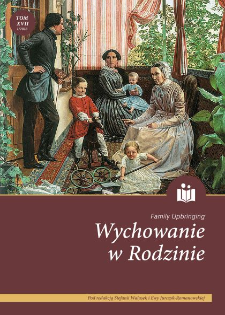Wizerunki dziecka kreowane przez strony parentingowe
Images of the child created by parenting websites
Author(s): Ewa Kubiak-Szymborska, Olga FurtakSubject(s): History, Social Sciences, Education, Sociology, Social history
Published by: Zakład Historii Edukacji w Instytucie Pedagogiki Uniwersytetu Wrocławskiego
Keywords: child; mediatization; parenting websites; image
Summary/Abstract: Aim. The issues of the child (and also of childhood) are relatively often addressed in various publications, revealing the multiplicity of aspects and contexts of these categories. The aim of this text is to consider the „child” category in the context of the phenomenon of mediatization which, in particular, comes down to looking at it from the perspective of the most popular parenting websites. Both images with a positive emotional charge as well those with a negative and ambivalent one are discussed in the text. They do not exhaust the spectrum of images of the child, but comprise those that appear most often on these websites and constitute a certain „added value” to the images presented by other researchers, looking at the child from the perspective of TV series and television programmes, or commercials. Method. While preparing the text, we used the method of secondary source analysis, with the sources being websites addressed to parents, also called parenting websites. A review and analysis of these websites prompted the authors to reflect on the image of the child created by them. Results. The results of our consideration illustrate, on the one hand, the scope anddiversity of the information, suggestions, and advice given to parents from the perspective of the images of the child created on the websites and, on the other hand, indicate the scope of social, cultural, and educational consequences resulting from „translating” the virtual image created on the websites into the real image of the child, his or her behaviour, relationships, attitude to others and to the world, and to its daily functioning. Conclusions. The review and analysis of parenting websites indicate that in the vast majority they present the image of the child, defined in this text as a child at risk, regardless of whether this risk lies in the enormous mass of disease causative agents (highest frequency), or in other factors related to the care and upbringing of the child, and the circumstances and conditions in which they take place (lower frequency). It gives rise to specific consequences. On the one hand, exhibiting such an image provides parents with the necessary knowledge sensitizing them to all kinds of factors that may turn out to be unfavourable to the child’s development while, on the other hand, creating such an image may result in parents’ excessive and unjustified fear of being a parent,or in being overprotective when caring for the child. Therefore, it is important to make parents aware of the fact that using parenting websites they should do so with caution and the necessary detachment from the information provided in them and, above all, keep common sense in assessing the content they come in contact with.
Journal: Wychowanie w Rodzinie
- Issue Year: XVII/2018
- Issue No: 1
- Page Range: 259-275
- Page Count: 17
- Language: English, Polish

